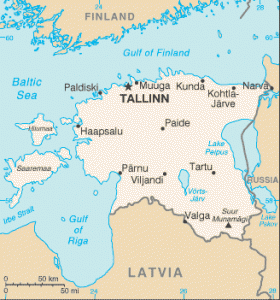Estonia adopted the EURO as its currency on January 1, 2011 at a period when there were growing concerns over the fate of the Euro zone in the face of growing debt by Greece. It became the first former Soviet Union country to adopt the Euro. Why should a country join such an economic union whose fate is unsure? Let us explore further.
After decades of being ruled by Denmark, Sweden, German and Russian rule- the country gained its independence in 1918, only to be forcibly integrated with USSR in 1940. After the fall of USSR in 1991, Estonia finally gained independence and adopted the Kroon as its currency in June 1992.

The location and size of the country has played a major role in determining the structure of the economy. It has a total area of slightly over 45000 sq.km (making it the 133rd country in the world in terms of area) and is surrounded by the Baltic Sea, the Gulf of Finland and has land boundaries with Latvia and Russia. Estonia follows an economic structure that is very open and market driven similar to western countries, however, its average income is half that of the other European nations. Its major trading partner is Norway and owing to the small size it is not possible for it to produce all the goods it needs. The net GDP of the country is 19.78 billion USD and is 24.69 billion USD in PPP terms making it the 113thlargest economy in the world. In terms of GDP per capita the country ranks 63rdin the world.
The structure of the economy: 71% services, 25% Industry and 4% primary branches (including agriculture). The industry segment is growing at a much more rapid rate in recent years whereas the service sector experienced the major boom post the soviet era. The major reason behind this huge domination of services is that in the soviet era Estonian factories were majorly used for weapon production. After the breakup of the union, there was a tremendous need for services which led to the boom. The economy is export driven and nearly 73% of the GDP is from exports with services contributing a third of exports. Another interesting fact of this economy is that its energy sector is driven by shale oil reserves and produces slightly more than 7000 bbl of oil each day. The unemployment though remains an issue with US data showing it at 17%. Tourism remains a major sector along with processing industry and business services for the country.
So what made this country join the Euro zone? Being an export oriented economy, joining the EU provided it a much larger market to grow its exports beyond its traditional trading partners like Norway. Furthermore, its tourism industry would have received a much greater benefit as a result of this integration. So joining the Euro zone was a natural choice, after joining the OECD in December 2010. So how is Estonia performing in the midst of the crisis? Its public debt is at 6.5% of its GDP among the lowest in the world. During the recent downgrade of EU countries by S&P, the credit rating of Estonia was retained at AA- though the outlook was lowered to negative due to the ongoing debt crisis. This rating is the second highest in Eastern Europe, next only to Slovakia. Its GDP grew at a rate of 8.5% in quarter 3, 2011 which is the highest in the 27 member European Union and it is expected to have a growth rate of 7.5% for 2011. Furthermore, exports have risen in the last quarter in 2011 due to rising demand from Norway and Sweden.
This 1.2 million people nation is definitely making the right moves in a union suffering from greater burdens of the debt crisis. Can it pave or rather show the way for a stronger Euro? It is expected that its economy will slow down in 2012 with growth rate touching around 3.1% in quarter I of 2012 (another factor for changing its outlook to negative by S&P). At the same point of time, its public finances and GDP structure are a model to behold, despite its small size. Overall, this is a country to watch out for and perhaps the good boy of Euro zone.
You might like reading:
Working Of Stock Exchange In India
Working of Stock Exchange in India When any owner / founder want to set up business/company, he has to put funds from his pocket. But there is no sufficient growth. Even if he taken loan from the banks, he might could not repay the loan. So, company comes to public to raise funds; ask public to invest money via trading […]

Decoding Venture Capitalists : How to approach and succeed !
India is full of talented budding entrepreneurs who have innovative ideas for starting a business. To implement their ideas they need certain minimum amount of capital for investment and generally they have to seek different alternatives for investment unless their family is supportive enough. Start ups are usually small enough to raise money from market and are also not in […]






























